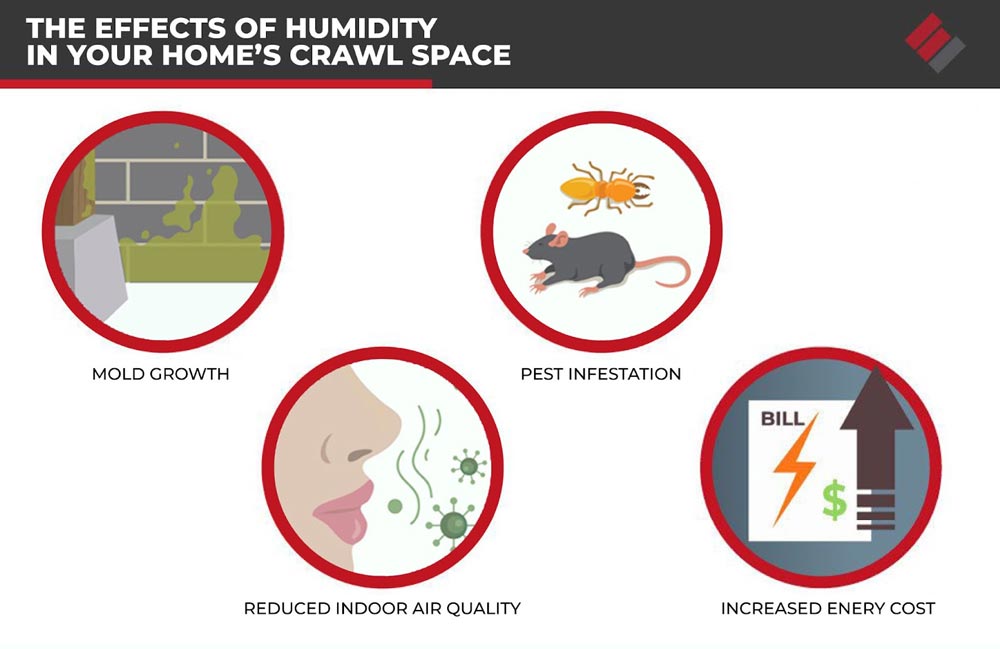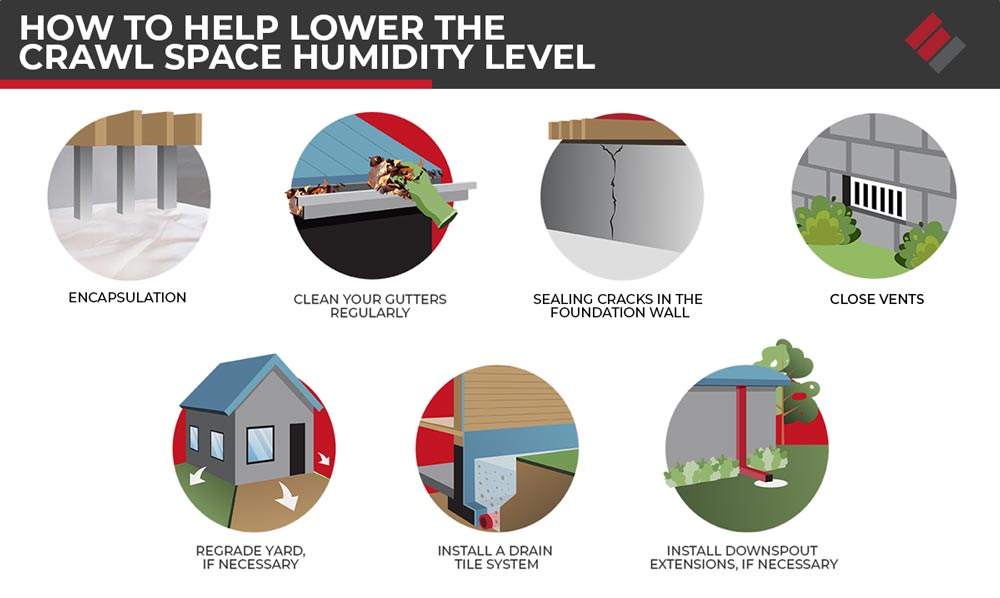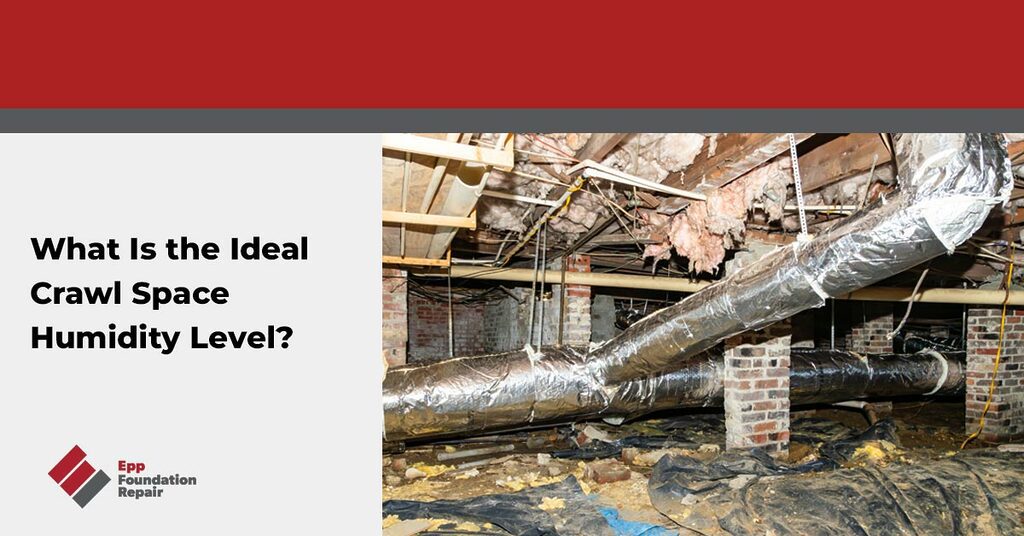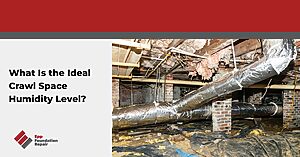Ensuring that crawl space humidity remains low is essential to keeping your home in tip-top shape. This means you need to understand why crawl space humidity matters and how best to manage it effectively. In this blog post, you’ll learn why you don’t want moisture and humidity in your crawl space, what the ideal humidity level is, how to keep crawl space humidity low, and more.
What Is a Crawl Space Foundation?
A crawl space foundation is a version of raised foundation that is typically used in residential homes instead of slab-on-grade or full basement foundations. In a crawl space foundation, the home’s ground floor is raised slightly off the ground, creating a space underneath ranging from 1-3 feet high, or just enough room to crawl around. Homeowners often prefer crawl space foundations because they are not only less expensive than basement foundations, but also offer easy access to the home’s plumbing and wiring.
While crawl space foundations have been popular for decades, they aren’t without their downsides–the main one of which is that they’re often plagued with moisture-related problems, which can lead to mold growth, costly termite damage, and even structural issues if they are not adequately addressed.
What’s the Best Crawl Space Humidity Level?
A crawl space humidity level between 45% and 55% will help prevent mold growth, wood rot, and pest infestations. This range promotes optimal air quality, contributing to a healthier home environment.
Why You Don’t Want Humidity in Your Home’s Crawl Space
A high level of humidity in your crawl space can have disastrous consequences, including:

- Mold growth – Mold can cause significant damage to the wooden structures in your crawl space, leading to weakened foundations and costly repairs.
- Pest infestations – A humid crawl space creates an ideal environment for pests like rodents, termites, and other insects to thrive. These invaders can chew through wood, electrical wiring, and insulation, causing extensive damage and posing health risks.
- Reduced indoor air quality – Excessive moisture in the crawl space promotes mold growth and other allergens that can harm your health. The presence of mold can result in respiratory problems, allergies, and asthma.
- Possibly increased energy costs – Due to airflow from the crawl space into your living area, there’s a possibility that you may be spending more to heat and cool your home. This is because humid air is harder to heat and cool.
What Causes a High Crawl Space Humidity Level?
The causes of high humidity in a crawl space include the following:
- Open crawl space vents – Uncovered crawl space vents permit warm, humid air to enter, resulting in condensation on cool surfaces.
- Poor drainage around the foundation – When moisture in the soil surrounding the foundation accumulates and cannot drain off, it can lead to a high crawl space humidity level.
- Foundation cracks – Even invisible cracks in the foundation can allow water to seep into the crawl space (especially when combined with poor drainage).
- Plumbing leaks – These can appear in the form of water or sewer pipes.
- High water table – If the water table is high, water can seep into the crawl space through the dirt floor.
- Heavy rainfall – Water-saturated soil around the foundation can contribute to elevated humidity levels in the crawl space.
Signs That There Might Be Humidity in the Crawl Space
Signs indicating excessive humidity in your crawl space include:
- Observable mold growth in the crawl space – Mold is a clear indication of high humidity within a crawl space. These fungi thrive in moist environments and can rapidly spread, posing health risks to individuals with allergies or respiratory conditions. If left unaddressed, mold can even cause structural damage to your home.
- Observable mold in your home’s living area – When there’s mold in the crawl space, you might also see mold on the floor or baseboards above it.
- Condensation – Condensation in your home’s living area could mean that there’s excess moisture in your crawl space.
- Pest infestations – The elevated humidity in your crawl space can attract pests such as termites and rodents. Once they’re inside, they can get into your living area above as well.
- Standing water – The presence of standing water in a crawl space indicates a drainage issue.
If you see any of the above happening in your home, contact a foundation repair contractor and ask for a crawl space evaluation.
How to Help Lower the Crawl Space Humidity Level
Lowering the humidity in your home’s crawl space can be achieved by taking the following measures:

- Encapsulation – Crawl space encapsulation involves sealing the vents and covering the floor and walls with a thick, vapor-retarding barrier. Adding a dehumidifier further helps to keep the crawl space dry.
- Cleaning your gutters regularly – Clogged gutters can lead to water overflow, soaking the ground around the foundation and increasing crawl space humidity.
- Sealing cracks in the foundation wall – Moisture infiltration can occur even through hairline cracks, so it’s important to seal them in order to prevent water seepage.
- Closing vents – In humid weather, open crawl space vents allow warm, moist air to enter and condense on cool surfaces. Close them if you want to keep the humidity level down.
- Regrading the yard, if needed – In cases where the ground around your home slopes toward the foundation, water can flow toward the crawl space as well. Regrading the yard to slope away from the house helps redirect water away from the foundation.
- Installing a drain tile system – A drain tile system efficiently directs excess moisture in the soil away from the foundation, preventing humidity buildup.
- Installing downspout extensions – Downspouts that discharge water next to the house can cause pooling near the foundation wall and entry into the crawl space. Divert rainwater away from the foundation with downspout extensions.
If you’re concerned about the humidity level in your home, contact us today to schedule a crawl space evaluation and receive a free estimate. We serve areas in Nebraska, Iowa, Kansas, and Missouri.







